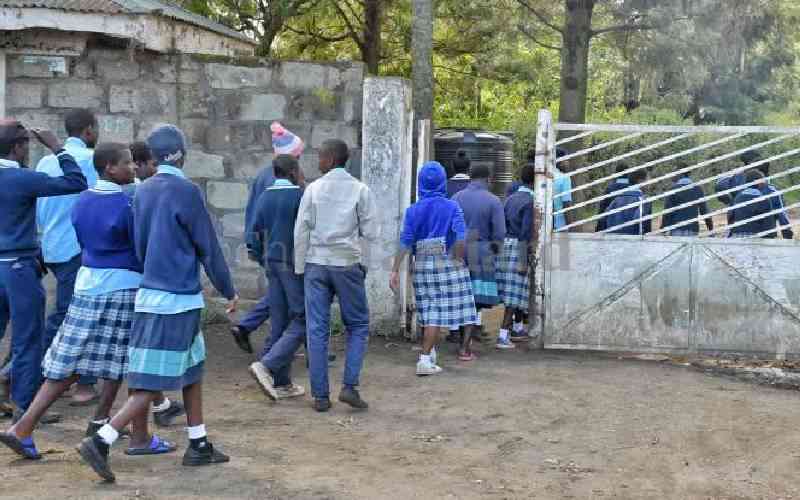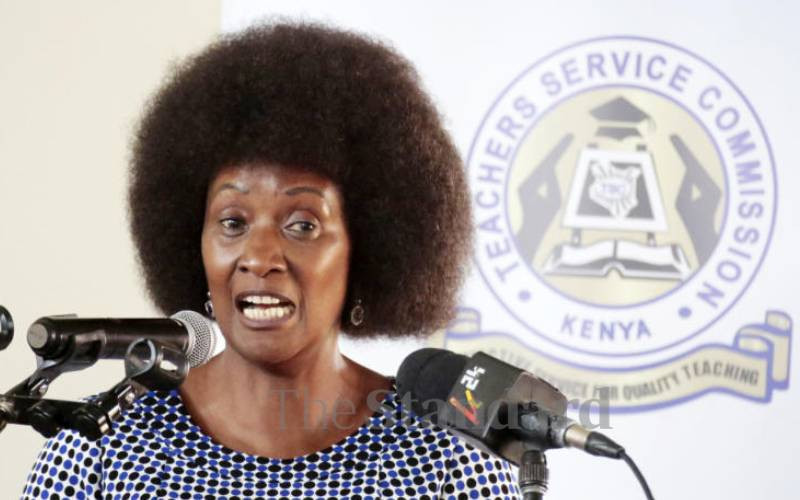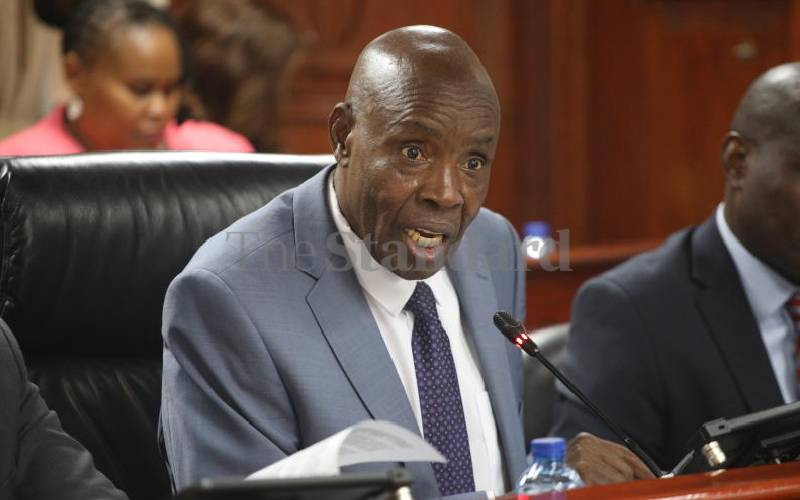
Students perform at the 60th edition of the annual Kenya Schools and Colleges Drama and Film Festival. [File]
Visible Thinking Routines (VTRs) are a series of steps that make complex thinking processes accessible to learners through the use of Visual Thinking. Visual Thinking is simply the process of thinking through visualisation. But what exactly makes VTRs effective? It's because of the interesting nature of humans -being visual thinkers. Our minds are designed to rapidly process and remember visual input. A well-designed visual image can generate a much more powerful, captivating and memorable learning experience than just a mere verbal or textual description. All students of all ages and types, including those specified as visual learners, can benefit from the use of VTRs in the classroom.
Too often, students are exposed to the final products of thought - the finished novel or painting, the established scientific theory etc. They rarely see the patterns of thinking that lead to these finished products, yet it is precisely these habits of mind that students need to develop. Being exposed to the steps leading to the acquisition of a certain skill, be it art, dancing, sewing, writing or sport are all more important than being exposed to the end product whether in art work, novel, dance performance, sport event, etc.
What do they entail?
Visible Thinking Routines target different ways of thinking. Some VTRs require students to work with others, promoting collaboration, and many help students learn to develop theories which they then strive to prove right or wrong. Visible Thinking makes extensive use of learning routines that are rich in thinking. These routines are simple structures, for example, a set of questions or a short sequence of steps that can be used across various grade levels and content. What qualifies them as routines, and not mere strategies, is that they get used over and over again in the classroom, so that they become part of the classroom culture. These routines become the ways in which students engage in learning. Instructors have an advantage as they can utilise more than one routine in teaching a single lesson.
How visible are they used in classrooms?
Visible Thinking Routines promote critical thinking skills in leaners. They function in several ways: VTRs function as tools educators use to encourage deep reasoning in their students. This helps children develop better research skills, to help them question what they currently believe, or to draw intelligent conclusions and inferences from the evidence presented. VTRs are mostly premised on scaffolding. They build 'a ladder' within the learner's mind that connects levels of thinking. Using VTRs, the learner begins at the bottom level of thinking, and uses the scaffold to climb to more advanced levels of thought. The VTRs a learner uses daily qualify as Patterns of Behaviour over time. This means children eventually use them without having to do so consciously. Routine becomes a habit, and habit become character, in a manner of speaking. Visible Thinking Routines target different ways of thinking, accordingly.
Why are they important?
Displaying visual thinking routines depicts what is happening in the classroom. First, visuals designed by the students add a colourful and decorative touch to the classroom. When a classroom is full of visual thinking routines, students sense their work is highly valued, respected, and appreciated. They also feel proud of their work. Second, exhibiting visual thinking routines in the classroom documents students' thinking.
The idea of documenting thinking encourages learning, as it provides both teachers and students scaffolding and metacognition opportunities. As a result, the classroom turns into a lively and dynamic learning environment that celebrates, sustains, and nurtures thinking. When displaying visual thinking routines in the classroom, every student occupies the same space in the display area no matter what his or her academic attainment is. Students can easily access their prior understanding, reflect on it, and add new acquired thoughts and ideas as their knowledge deepens and extends. Therefore, the classroom walls come alive with learning, and students become surrounded by their views, opinions, ideas, concerns, and questions.
Reinforce student thinking and questioning
Thinking time is one of the most fundamental factors for the meaningful and effective implementation of visual thinking routines. Such thinking routines are inclusive and open-ended in nature, which allows for students' questions, contributions, and thinking. Students engaged in visual thinking routines are at all times involved in various thinking attributes which include building up from prior knowledge, observing, making meaning and interpreting, reasoning, seeing relationships, making judgments, considering different perspectives and points of view, making connections, and reflecting on one's thoughts. When students think out loud, they talk out their mental states: what they are thinking, wondering, challenging, and feeling.
A 2017 journal published by Dr Alain Gholam, Assistant Professor of Education at the American University in Dubai, provided insights on the Visual Thinking Routines approach applied to student teachers at the American University in Dubai. Visual thinking routines were implemented in the teaching methodology graduate course at the American University in Dubai.
The key question of 'How do visual thinking routines inspire learning in the classroom, and make time for students' questions, contributions, and thinking,' was answered. Eight student teachers enrolled in the teaching methodology course at the American University in Dubai (Spring 2017) participated in the study. First, they completed a survey that measured to what degree they believed visual thinking routines inspired learning in the classroom and made time for students' questions, contributions, and thinking.
In order to build on the results from the quantitative phase, the student teachers were next involved in a qualitative data collection phase, where they had to answer the question: How do visual thinking routines inspire learning in the classroom and make time for students' questions, contributions, and thinking? Results revealed that the implementation of visual thinking routines in the classroom strongly inspired learning in the classroom and made time for students' questions, contributions, and thinking. In addition, student teachers explained how visual thinking routines allowed for visibility and reinforced thinking skills and questioning.
How can they be applied in our context?
Given the benefits and importance of including visual thinking routines in daily curricula, how do schools create a thinking culture? What are the essential elements needed to make sure visual thinking routines are effectively and efficiently implemented in schools? Schools need to believe in a culture of thinking. Therefore, it is important that school administrators and coordinators design curricula that promotes student engagement, thinking, questioning, and 21st Century education.
Teachers must be well equipped with the knowledge and skills needed to design and implement effective visual thinking routines in the classroom. In order to do so, teachers need to participate in study group programs related to visual thinking routines. Teachers need to have quality time to share and exchange ideas acquired from the study group programmes.
Teachers should also be given a trial period to implement visual thinking routines in the classroom and prepare an evaluation of the process: the strengths, the weaknesses, what could be done better, etc. Trained/experienced teachers {in visual thinking routines} should, on the other hand, offer hands-on training to the new ones in the field, or those not familiar with the use of visual thinking routines. Teachers ought to participate in ongoing professional development programs related to visual thinking routines. Such ongoing professional development programs help teachers stay up to date with the recent trends in visual thinking routines in the education realm.
Educators need to make sure they equip students with the skills and knowledge they need to successfully face the outcomes of the 21st Century. They need to make sure they prepare learners for the future and embark on a leading career path. To do so, students need to be active participants in the learning process. Students, collaboratively, need to observe their surroundings, ask questions, wonder, experiment, predict, formulate hypotheses, test hypotheses, arrive at conclusions, communicate their findings, and definitely take action to serve the world. Hence, visual thinking routines in the classroom will contribute to a 21st-century education.
What are the indicators of success?
Visual thinking routines affect the classroom culture. When a teacher makes use of visual thinking routines, the classroom becomes appreciable and discernible. Thinking becomes visible, students are intentionally aware of their thinking, and teachers chart progress by recalling evidence of students' thinking, and therefore, thinking becomes highly valued in such classrooms.
Students become well equipped with sufficient opportunities to express, explain, extend, and challenge their ideas. In return, students become active, curious, engaged, enthusiastic, and responsible learners. When students are actively involved in the learning process, they become meaningfully engaged and highly motivated and reach an enduring understanding that is transferable across real-life situations. With visual thinking routines, a teacher never receives an: "I can't do it" response.
Finally, considering the importance of making student thinking visible through the use of visual thinking routines, teachers, administrators, and parents must ensure rich and unique learning environments that bring out the best in every student, take learning to a new level, and drive all students on a lifelong learning full of explorations, investigations, and inquiries. Today's global classrooms are finding Visual Thinking exercises an especially constructive classroom tool that can help boost students' critical thinking, literacy, observation, and evidentiary skills.
To make the most of this useful resource, visual thinking routines need to be highly valued at all academic levels starting from early stages. It is essential that such routines become embedded in the curriculum to allow for a rich, meaningful learning journey that incorporates questioning, thinking, and deep understanding.
 The Standard Group Plc is a multi-media organization with investments in media platforms spanning newspaper print
operations, television, radio broadcasting, digital and online services. The Standard Group is recognized as a
leading multi-media house in Kenya with a key influence in matters of national and international interest.
The Standard Group Plc is a multi-media organization with investments in media platforms spanning newspaper print
operations, television, radio broadcasting, digital and online services. The Standard Group is recognized as a
leading multi-media house in Kenya with a key influence in matters of national and international interest.











